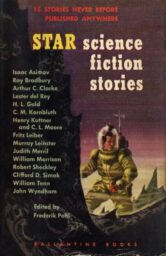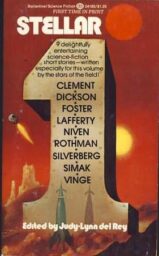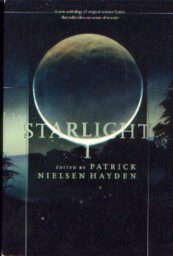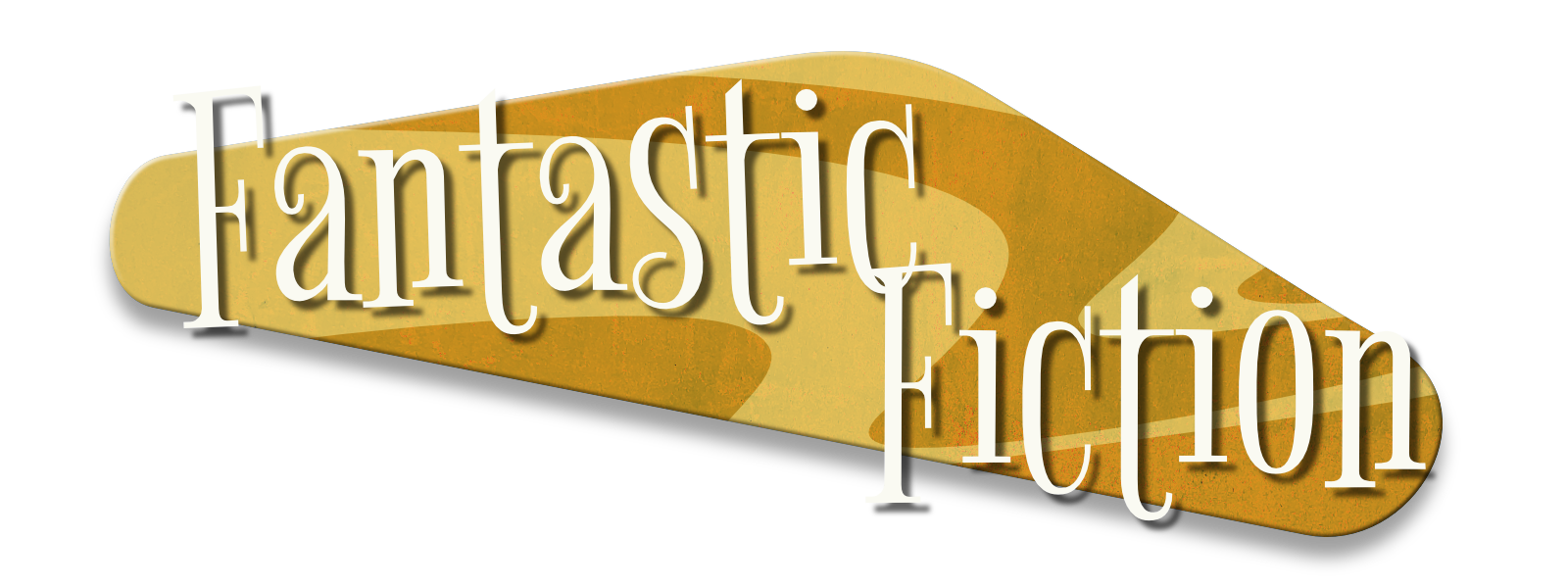One of the delights of reviewing is following the development of a good idea through many decades. Take, for example, the progeny of Frederik Pohl’s Star Science Fiction anthologies.
 The first Star anthology appeared in 1953. Five more volumes, as well as a collection of “short novels,” as they were called then (novellas now), followed, as well as a selection of the best stories, published as Star of Stars [Note 1]. The quality of Pohl’s anthologies is impressive; flipping through my copies reveals classic stories such as Arthur C. Clarke’s “The Nine Billion Names of God,” Jerome Bixby’s “It’s a Good Life,” and Fritz Leiber’s “Space-Time For Springers.” It’s a shame the series is out of print [Note 2].
The first Star anthology appeared in 1953. Five more volumes, as well as a collection of “short novels,” as they were called then (novellas now), followed, as well as a selection of the best stories, published as Star of Stars [Note 1]. The quality of Pohl’s anthologies is impressive; flipping through my copies reveals classic stories such as Arthur C. Clarke’s “The Nine Billion Names of God,” Jerome Bixby’s “It’s a Good Life,” and Fritz Leiber’s “Space-Time For Springers.” It’s a shame the series is out of print [Note 2].
 In 1974, Judy-Lynn del Rey’s Stellar 1 appeared. Stellar 1 was followed by six sequels, as well as a novella anthology, Stellar Short Novels. The parallels with Pohl’s series are no coincidence. As del Rey explains in her introduction to her Stellar Short Novels, she very much had Pohl’s Star Science Fiction in mind when she created her series. Del Rey’s purpose was to prove there was still a market for straightforward adventure fiction [Note 3. While the result wasn’t quite as noteworthy as Pohl’s, it did foreshadow the manner in which the Del Rey imprint provided reliably entertaining material.
In 1974, Judy-Lynn del Rey’s Stellar 1 appeared. Stellar 1 was followed by six sequels, as well as a novella anthology, Stellar Short Novels. The parallels with Pohl’s series are no coincidence. As del Rey explains in her introduction to her Stellar Short Novels, she very much had Pohl’s Star Science Fiction in mind when she created her series. Del Rey’s purpose was to prove there was still a market for straightforward adventure fiction [Note 3. While the result wasn’t quite as noteworthy as Pohl’s, it did foreshadow the manner in which the Del Rey imprint provided reliably entertaining material.
 Lately we’ve had Patrick Nielsen Hayden’s Starlight series (1996—2001). The parallels with Star Science Fiction are weaker. There were only two subsequent volumes of Starlight anthologies. However, Nielsen Hayden namechecks Star in his introduction. Furthermore, the quality of the Starlight anthologies is as exemplary as Pohl’s. It is of such quality that one reviewer [Note 4] bizarrely recommended that one not buy the Starlight books themselves because the contents were so good that they would surely appear in various annual Best SF collections. This sort of advice is not how you get more installments, people.
Lately we’ve had Patrick Nielsen Hayden’s Starlight series (1996—2001). The parallels with Star Science Fiction are weaker. There were only two subsequent volumes of Starlight anthologies. However, Nielsen Hayden namechecks Star in his introduction. Furthermore, the quality of the Starlight anthologies is as exemplary as Pohl’s. It is of such quality that one reviewer [Note 4] bizarrely recommended that one not buy the Starlight books themselves because the contents were so good that they would surely appear in various annual Best SF collections. This sort of advice is not how you get more installments, people.
I wouldn’t be surprised to discover Star Science Fiction had more progeny. In fact, I’d be delighted to find out that it did.
Notes
- Known as Star Fourteen in the UK, which might have sent readers off on wild goose chases for Stars Seven through Thirteen.
There was also a one-off Star magazine, released about the time the American News Company was liquidated. ANC distributed about half of the magazines sold in the U.S. before the liquidation, which may be why there was no issue number two.
- Thanks to the huge print runs common when the 1970s editions of the Star Science Fiction anthologies appeared, I still see a copy or two when I peruse used bookstores.
- I’d remembered Stellar 1 as a counter-reaction to the New Wave, but rereading reveals that del Rey was vexed at academics for some reason.
- Not me.
James Davis Nicoll is a book reviewer and five-time Hugo finalist, four-time Aurora finalist, and CSFFA Hall of Fame nominee. His work can be found at James Nicoll Reviews.


Thanks for writing about the first anthology series of original SF.
Was it the very first? I knew it was early.
According to the online SF encyclopedia, the first successful original anthology was New Tales of Time and Space, edited by Raymond Healy in 1951. (Apparently there was an original SF anthology as early as 1937, but that one was all unknowns and sank without a trace)
https://sf-encyclopedia.com/entry/anthologies
There was also the Nova series, edited by Harry Harrison, but only four of them that I am aware of. I don’t know (because I haven’t had copies for over fifty years), but strongly suspect, that they were also of the same lineage.
I can only seem to find the contents of the first one, because they’re listed on W’pedia, but the contents of that one are pretty solid, with old guarders from Ray Bradbury to Bob Silgerverb, newwavers like James Sallis and Barry Malzberg (twice) and David Gerrold (oh my!) and reliables like Gordie Dickson, Brian Aldiss, and, well, Piers Anthony. Plus one of Donald Westlake’s rare SF stories.
May God continue to bless the The Internet Speculative Fiction Database.
Nova 1 contents: https://www.isfdb.org/cgi-bin/pl.cgi?194241
Nova 2 contents: https://www.isfdb.org/cgi-bin/pl.cgi?24586
Nova 3 contents: https://www.isfdb.org/cgi-bin/pl.cgi?24589
Nova 4 contents: https://www.isfdb.org/cgi-bin/pl.cgi?24591
Most or all pieces have their own index page in ISFDB, which might only say “published in Nova”. The “Nova 1” page contains dates of the contents, perhaps because a couple of pieces apparently are older than 1970. A few others that I checked from the series are listed appearing first in “Nova”. I recognise one title – you may too – “Zirn Left Unguarded, the Jenghik Palace in Flames, Jon Westerley Dead”. What happens in the story? Well – that, pretty much.
I don’t know whether they all count as “progeny” of Star, but I now have 21 unthemed-original-anthology series on my list:
https://www.kith.org/jed/hodgepodge/nonfiction/prestigious-unthemed-original-anthology-sf-series/